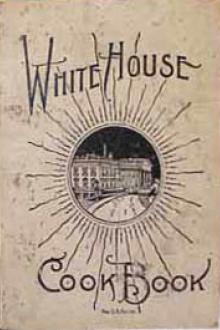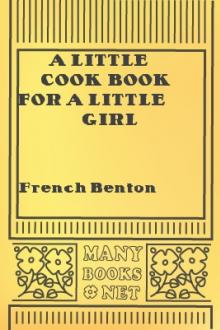The Whitehouse Cookbook (1887), Hugo Ziemann [world of reading .TXT] 📗

- Author: Hugo Ziemann
- Performer: -
Book online «The Whitehouse Cookbook (1887), Hugo Ziemann [world of reading .TXT] 📗». Author Hugo Ziemann
TO MAKE SOFT SOAP WITHOUT COOKING.
Pour two pailfuls of boiling water upon twenty pounds of potash and let it stand two hours. Have ready thirty pounds of clean grease, upon which pour one pailful of the lye, adding another pail of water to the potash; let it stand three or four hours, stir it well; then pour a gallon of the lye upon the grease, stir it well; and in half an hour another gallon of the lye, stir it thoroughly; in half an hour repeat the process, and thus proceed until you have poured off all the lye; then add two pails of boiling hot water to the remainder of the potash, and let it stand ten hours; then stir the mixture, and if it has become stiff and the grease has disappeared from the surface, take out a little and see whether the weak lye will thicken it; if it does, add the lye; if it does not, try water, and if that thickens it, let it stand another day, stirring it well five or six times during the day; if the lye does not separate from the grease you may fill up with water.
OLD-STYLE FAMILY SOFT SOAP.
To set the leach, bore several holes in the bottom of a barrel, or use one without a bottom; prepare a board larger than the barrel, then set the barrel on it, and cut a groove around just outside the barrel, making one groove from this to the edge of the board, to carry off the lye as it runs off, with a groove around it, running into one in the centre of the board. Place all two feet from the ground and tip it so that the lye may run easily from the board into the vessel below prepared to receive it. Put half bricks or stones around the edge of the inside of the barrel; place on them one end of some sticks about two inches wide, inclining to the centre; on those place some straw to the depth of two inches, over it scatter two pounds of slaked lime. Put in ashes, about half of a bushel at a time, pack it well, by pounding it down, and continue doing so until the barrel is full, leaving a funnel-shaped hollow in the centre large enough to hold several quarts of water. Use rain-water boiling hot. Let the water disappear before adding more. If the ashes are packed very tightly it may require two or three days before the lye will begin to run, but it will be the stronger for it, and much better.
To Make Boiled Soft Soap.—Put in a kettle the grease consisting of all kinds of fat that has accumulated in the kitchen, such as scraps and bones from the soup-kettle, rinds from meat, etc.; fill the kettle half full; if there is too much grease it can be skimmed off after the soap is cold, for another kettle of soap. This is the only true test when enough grease is used, as the lye will consume all that is needed and no more. Make a fire under one side of it. The kettle should be in an out-house or out of doors. Let it heat very hot so as to fry; stir occasionally to prevent burning. Now put in the lye a gallon at a time, watching it closely until it boils, as it sometimes runs over at the beginning. Add lye until the kettle is full enough, but not too full to boil well. Soap should boil from the side and not the middle, as this would be more likely to cause it to boil over. To test the soap, to one spoonful of soap add one of rain-water; if it stirs up very thick, the soap is good and will keep; if it becomes thinner, it is not good. This is the result of one of three causes, either it is too weak, or there is a deposit of dirt or it is too strong. Continue to boil for a few hours, when it should flow from the stick with which it is stirred like thick molasses; but if after boiling it remains thin, let it stand over night, removing it from the fire, then drain it off very carefully into another vessel, being very particular to prevent any sediment from passing. Wash the kettle, return the soap and boil again, if dirt was the cause; it will now be thick and good; otherwise if it was too strong, rain-water added will make it right, adding the water gradually until right and just thick enough.
An Agreeable Disinfectant:—Sprinkle fresh ground coffee on a shovel of hot coals, or burn sugar on hot coals. Vinegar boiled with myrrh, sprinkled on the floor and furniture of a sick room, is an excellent deodorizer.
To Prevent Mold:—A small quantity of carbolic acid added to paste, mucilage and ink, will prevent mold. An ounce of the acid to a gallon of whitewash will keep cellars and dairies from the disagreeable odor which often taints milk and meat kept in such places.
To Make Tracing-Paper:—Dissolve a ball of white beeswax, one inch in diameter, in half a pint of turpentine. Saturate the paper in this bath and let it dry two or three days before using.
To Preserve Brooms:—Dip them for a minute or two in a kettle of boiling suds once a week and they will last much longer, making them tough and pliable. A carpet wears much longer swept with a broom cared for in this manner.
To Clean Brass-Ware, etc.:—Mix one ounce of oxalic acid, six ounces of rotten stone, all in powder, one ounce of sweet oil, and sufficient water to make a paste. Apply a small portion, and rub dry with a flannel or leather. The liquid dip most generally used consists of nitric and sulphuric acids; but this is more corrosive.
Polish or Enamel for Shirt Bosoms is made by melting together one ounce of white wax, and two ounces of spermaceti; heat gently and turn into a very shallow pan; when cold cut or break in pieces. When making boiled starch the usual way, enough for a dozen bosoms, add to it a piece of the polish the size of a hazel nut.
An Erasive Fluid for the Removal of Spots on Furniture, and all kinds of fabrics, without injuring the color, is made of four ounces of aqua ammonia, one ounce of glycerine, one ounce of castile soap and one of spirits of wine. Dissolve the soap in two quarts of soft water, add the other ingredients. Apply with a soft sponge and rub out. Very good for deaning silks.
To Remove the Odor of Onion from fish-kettle and saucepans in which they have been cooked, put wood-ashes or sal soda, potash or lye; fill with water and let it stand on the stove until it boils; then wash in hot suds, and rinse well.
To Clean Marble Busts:—First free them from all dust, then wash them with very weak hydrochloric acid. Soap injures the color of marble.
To Remove old Putty from Window Frames, pass a red hot poker slowly over it and it will come off easily.
Hanging Pictures:—The most safe material and also the best, is copper wire, of the size proportioned to the weight of the picture. When hung the wire is scarcely visible, and its strength is far superior to cord.
To Keep Milk Sweet:—Put into a panful a spoonful of grated horse-radish, it will keep it sweet for days.
To Take Rust from Steel Implements or Knives:—Rub them well with kerosene oil, leaving them covered with it a day or so; then rub them hard and well with finely powdered unslaked lime.
Poison Water:—Water boiled in galvanized iron becomes poisonous, and cold water passed through zinc-lined iron pipes should never be used for cooking or drinking. Hot water for cooking should never be taken from hot water pipes; keep a supply heated in kettles.
Scouring Soap for Cotton and Silk Goods:—Mix one pound of common soap, half a pound of beef-gall and one ounce and a half of Venetian turpentine.
A Paint for Wood or Stone that Resists all Moisture:—Melt twelve ounces of resin; mix with it, thoroughly, six gallons of fish oil and one pound of melted sulphur. Rub up some ochre or any other coloring substance with a little linseed oil, enough to give it the right, color and thickness. Apply several coats of the hot composition with a brush. The first coat should be very thin.
To Ventilate a Room:—Place a pitcher of cold water on a table in your room and it will absorb all the gases with which the room is filled from the respiration of those eating or sleeping in the apartment. Very few realize how important such purification is for the health of the family, or, indeed, understand or realize that there can be any impurity in the rooms; yet in a few hours a pitcher or pail of cold water—the colder the more effective—will make the air of a room pure, but the water will be entirely unfit for use.
To Fill Cracks in Plaster:—Use vinegar instead of water to mix your plaster of Paris. The resultant mass will be like putty, and will not "set" for twenty or thirty minutes; whereas, if you use water the plaster will become hard almost immediately, before you have time to use it. Push it into the cracks and smooth it off nicely with a table knife.
To Take Spots from Wash Goods:—Rub them with the yolk of egg before washing.
To Take White Spots from Varnished Furniture:—Hold a hot stove lid or plate over them and they will soon disappear.
To Prevent Oil from Becoming Rancid:—Drop a few drops of ether into the bottle containing it.
Troublesome Ants:—A heavy chalk mark laid a finger's distance from your sugar box and all around (there must be no space not covered) will surely prevent ants from troubling.
To Make Tough Meat Tender:—Lay it a few minutes in a strong vinegar water.
To Remove Discoloration from Bruises:—Apply a cloth wrung out in very hot water, and renew frequently until the pain ceases. Or apply raw beefsteak.
A Good Polish for Removing Stains, Spots and Mildew from Furniture is made as follows: Take half a pint of ninety-eight per cent, alcohol, a quarter of an ounce each of pulverized resin and gum shellac, add half a pint of linseed oil; shake well and apply with a brush or sponge.
To Remove Finger-Marks:—Sweet oil will remove finger-marks from varnished furniture, and kerosene from oiled furniture.
To Remove Paint from Black Silk:—Patient rubbing with chloroform will remove paint from black silk or any other goods, and will not hurt the most delicate color or fabric.
To Freshen Gilt Frames:—Gilt frames may be revived by carefully dusting them, and then washing with one ounce of soda beaten up with the whites of three eggs. Scraped patches might be touched tip with any gold paint. Castile soap and water, with proper care, may be used to clean oil paintings; other methods should not be employed without some skill.
To Destroy Moths in Furniture:—All the baking and steaming are useless, as, although the moths may be killed, their eggs are sure to hatch, and the upholstery to be well riddled. The naphtha-bath process is effectual. A sofa, chair or lounge may be immersed in the large vats used for the purpose, and all insect life will be





Comments (0)